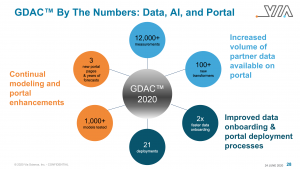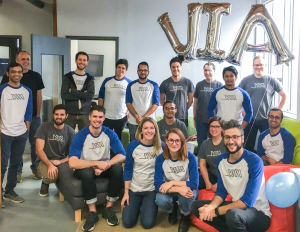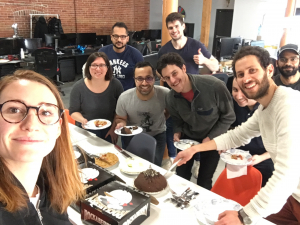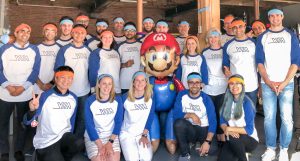Through a Q&A-style interview, you will hear from VIA team members about things like a typical day at the office and favorite foods.
What does a typical day at VIA look like for you?
My typical workday starts with a coffee, from either one of the local third-wave coffee shops or the machine at work. Once I’m settled, I look at my calendar and plan my day, this can be anything from looking at notes from a previous meeting to making sure I’ve booked a room. When that’s complete, I look for something I can quickly finish before Scrum of Scrums or continue with the task from the day before.
Each day at 10:30, I attend Scrum of Scrums. As a technical lead, I need to know how my epic is progressing, so typically, I will check in with my colleagues before the meeting for any updates and check that the JIRA board reflects our current progress. Typically, there are a few meetings to take a deeper dive on topics raised at Scrum of Scrums. These are a great way to make sure that we are aligned across our epics and to share knowledge.
Having conditioned myself over many years that 12 o’clock means lunchtime, I take a break at 12 to either buy lunch or heat up some leftovers. Lunch is a great opportunity to socialize with my colleagues on different epics and to give my brain some time to process in the background. Conversations range from the latest computer game, movies, and hockey, but mostly food.
After lunch, my afternoons consist of meetings, customer calls, and development time. My time tends to be split into hour-long chunks which I’ve planned out in the morning. A lot of my work revolves around supporting my colleagues by answering questions, problem-solving, and pair-programming. One of the favourite ways to tackle a problem is to jump into a spare room and rubber duck the problem. Basically, by describing a problem to a rubber duck, you verbalise the issues you are facing and through this process, you tend to have a better understanding of your problem. Luckily, VIA has hired people rather than rubber ducks, so in fact, you can also get feedback, questions, and suggestions from your colleagues.
At the end of the day, which is typically signaled by the sending of GIFs on Slack that it’s home time, I make sure to leave my work in a state that allows me to continue the next day.
What’s something you have worked on at VIA that you are most proud of?
At VIA, I have had the opportunity to work on many different projects. I’m proud of every single one of them, but if I have to choose one, then I am most proud of the GDAC™ Transformers project. The reason I have chosen this project is because it is the first application built on top of TAC™. I’m proud to have helped develop TAC™, but it’s even better to use it for the benefit of our partners. The partnership aspect is another element that makes me proud to have worked on GDAC™ Transformers. I have worked closely with our partners for almost a year and to see how far we’ve come together is fantastic. Having had the opportunity to meet our partners in person, I was able to see how the work we have done together will benefit them going forward.
What’s your favorite VIA memory?
VIA is a great place to work, I have so many memories from my time here. One that stands out to me, in particular, was “Game Night”. Each offsite (a company-wide in-person event where we talk about wins, solve project challenges, and plan for the next big thing) typically has an activity where we have a chance to socialize such as bowling, mini-golf, and a scavenger hunt. But, nothing quite beats seeing your own office converted, in-secret, to the ultimate “Game Night” experience to the point where it is almost unrecognizable and something I will never forget.

If you were given an extra hour in your day, what would you spend it doing?
One thing I say to myself quite often is “If only I had more time”, but what would I do with that extra time. If I had an extra hour in my day, I would like to improve my French. Montreal is a fantastic bilingual city and very little French is actually necessary, but to really appreciate its culture and to get the full Quebecois experience a good handle on French is essential.
What’s your go-to food?
My go-to food has to be a sandwich, you can’t beat the convenience, variety, and taste of a good sandwich. In particular, I’m a big fan of a bacon butty, which, for those of you who are unfamiliar, is a very basic sandwich with bacon and butter filling. Bacon buttys tend to be eaten in the morning at home or out and about. They are an excellent way to start the day if camping, at a sports event, or just a day of gardening.
What’s something everyone may not, but should know about working at VIA?
If you have the pleasure of working at VIA then you should know that using GIFs in presentations and on Slack is encouraged. Communicating context and meaning using just text can be difficult at times, but GIFs can add so much more. A strong GIF game is essential to signal it’s time to go home, go to the pub, play badminton, get bread, or celebrate the latest prize that VIA has won.





